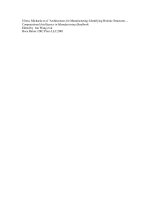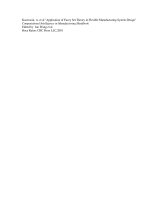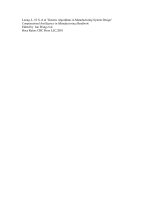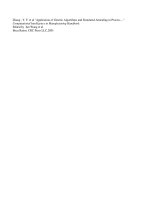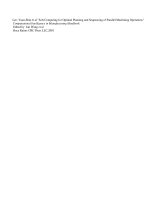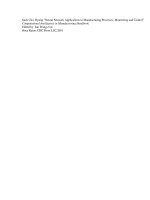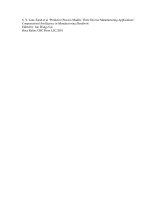Computational Intelligence In Manufacturing Handbook P6
Bạn đang xem bản rút gọn của tài liệu. Xem và tải ngay bản đầy đủ của tài liệu tại đây (524.01 KB, 26 trang )
Luong, L. H. S. et al "Genetic Algorithms in Manufacturing System Design"
Computational Intelligence in Manufacturing Handbook
Edited by Jun Wang et al
Boca Raton: CRC Press LLC,2001
©2001 CRC Press LLC
6
Genetic Algorithms
in Manufacturing
System Design
6.1 Introduction
6.2 The Design of Cellular Manufacturing Systems
6.3 The Concepts of Similarity Coefficients
6.4 A Genetic Algorithm for Finding the Optimum Process
Routings for Parts
6.5 A Genetic Algorithm to Cluster Machines
into Machine Groups
6.6 A Genetic Algorithm to Cluster Parts into
Part Families
6.7 Layout Design
6.8 A Genetic Algorithm for Layout Optimization
6.9 A Case Study
6.10 Conclusion
6.1 Introduction
Batch manufacturing is a dominant manufacturing activity in many industries due to the demand for
product customization. The high level of product variety and small manufacturing lot sizes are the major
problems in batch manufacturing systems. The improvement in productivity is therefore essential for
industries involved in batch manufacturing.
Group technology is a manufacturing philosophy for improving productivity in batch production
systems and tries to retain the flexibility of job shop production. The basic idea of group technology
(GT) is to divide a manufacturing system including parts, machines, and information into some groups
or subsystems. Introduction of group technology into manufacturing has many advantages, including a
reduction in flow time, work-in-process, and set-up time. One of the most important applications of
group technology is cellular manufacturing system. A
cellular manufacturing system
is a manufacturing
system that is divided into independent groups of machine cells and part families so that each family of
parts can be produced within a group of machines. This allows batch production to gain economic
advantages of mass production while retaining the flexibility of job shop methods. Wemmerlov and Hyer
[1986] defined cellular manufacturing as follows:
A manufacturing cell is a collection of dissimilar machines or manufacturing processes dedicated to
a collection of similar parts and cellular manufacturing is said to be in place when a manufacturing
system encompasses one or more such cells.
L. H. S. Luong
University of South Australia
M. Kazerooni
Toosi University of Technology
K. Abhary
University of South Australia
©2001 CRC Press LLC
When some forms of automation are applied to a cellular manufacturing system, it is usually referred
to as a flexible manufacturing system (FMS). These forms of automation may include numerically
controlled machines, robotics, and automatic guided vehicles. For these reasons, FMS can be regarded
as a subset of cellular manufacturing systems, and the design procedures for both cellular manufacturing
systems and FMS are similar.
The benefits of cellular manufacturing system in comparison with the traditional functional layout
are many, including a reduction in set-up time, work-in-process, and manufacturing lead-time, and an
increase in product quality and job satisfaction. These benefits are well documented in literature. This
chapter presents an integrated methodology for the design of cellular manufacturing systems using genetic
algorithms.
6.2 The Design of Cellular Manufacturing Systems
The first step in the process of designing a cellular manufacturing system is called
cell formation
. Most
approaches to cell formation utilize a machine-component incidence matrix, which is derived and
oversimplified from the information included in the routing sheets of the parts to be manufactured. A
typical machine-component incidence matrix is shown in Figure 6.1. The a
ji
, which is the (
j
,
i
)
th
entry of
this matrix, is 1 if the part
i
requires processing on machine
j
and a
ji
is otherwise 0. Many attempts have
been made to convert this form of matrix to a block diagonal form, as shown in Figure 6.2. Each block
in Figure 6.2 represents a potential manufacturing cell. Not all incidence matrices can be decomposed
to a complete block diagonal form. This problem can come from both
exceptional elements
and
bot-
tleneck machines
. There are two possible ways to deal with exceptional elements. One way is to investigate
alternative routings for all exceptional elements and choose a process route that does not need any
machine from another cell. However, this solution cannot be achieved in most cases. Another way is
subcontracting the exceptional elements to other companies. If there are not many exceptional elements,
this way seems more reasonable, although it may incur extra handling costs and create problems with
production planning and control.
In the presence of bottleneck machines, the system cannot be decomposed into independent cells, and
some intercellular movements are inevitable. The impact of bottleneck machines on the system is increas-
ing usage of material handling devices due to parts moving amongst the cells. Obviously a high number
of intercellular movements will lead to an increase in material handling costs. Therefore, to decrease the
FIGURE 6.1
An init ial ma chine–component matrix.
PARTS
1 2 3 4 5 6 7 8 910111213141516171819202122232425262728293031323334353637383940
11 1111 1
21 11 1 11
31 1111
41 1111
51 11
61 11 1
711 11 1
81 1 1 1
91 11 11 1
10 1 111
11 1 1 1 1 1
12 1 1 1 1 1 1
13 1 1 1 1 1 1
14 1 1 1 1
15 1 1 1 1 1
16 1 1 1 1 1
17 1 1 1 1 1 1 1
18 1 1 1 1 1 1
19 1 1 1 1 1
20 1 1 1 1 1
21 1
22 1 1 1 1 1 1 1 1
23 1 11 1
24 1 1 1 1 1 1 1 1
25 111
26 1 1 1 111
27 1 111 1
28 1 111
29 1 11 1
30
11 1 111 1
M
A
C
H
I
N
E
S
©2001 CRC Press LLC
number of intercellular movements, some or all bottleneck machines should be duplicated. However,
duplicating of bottleneck machines is not always economical. To justify which machine is to be duplicated,
some subproblems including
clustering procedure
,
intracell layout,
and
intercell layout
of machines
should be considered simultaneously in any attempt to optimize the design.
The above discussion indicates that the design of cellular manufacturing systems can be divided into
two major stages: cell formation and system layout. The activities in the cell formation stage include
constructing a group technology database of parts and their process routings, finding the most suitable
routings among parts’ alternative routings, grouping machines into machine groups, and forming parts
into part families dedicated to the machine groups. In the system layout stage, the activities are selecting
candidates for machine duplication, designing intercellular and intracellular layout, and detailed design.
As in any design process, the design of cellular manufacturing systems should take into consideration
all relevant production parameters, design constraints, and design objectives. The relevant production
parameters are process routings of parts, parts’ production volume or annual demand, parts’ alternative
routings, processing time of each operation, and machine capacity or machine availability. There are also
some constraints that should be considered while designing a cellular manufacturing system, such as
minimum and/or maximum cell size, minimum and/or maximum number of cells, and maximum
number of each machine type. In design optimization, there are many design objectives with regard to
a cellular manufacturing system that can be considered individually or combinatorially. The design
objectives may include minimizing intercellular movements, minimizing set-up time, minimizing
machine load variation or maximizing machine utilization, and minimizing the system’s costs. Some of
these objectives can be conflicting. The goal of attaining all of these objectives, and at the same time
satisfying the relevant design constraints, is a challenging task and may not be achievable because of
conflicting objectives.
Many analytical, heuristic, cost-based and artificial intelligence techniques have been developed for
solving the cell formation problem. Some examples are branch and bound method [Kusiak et al., 1991],
nonlinear integer programming [Adil et al., 1996], cellular similarity [Luong, 1993], fuzzy technique [Lee
et al., 1991], and simulated annealing [Murthy and Srinivasan, 1995]. There are also a number of review
papers in this area. Waghodekar and Sahu [1983] provide an exhaustive bibliography of papers on group
technology that appeared from 1928 to 1982. They also have classified the bibliography into four cate-
gories relating to both design and operational aspects. Another extensive survey with regard to different
aspects of cellular manufacturing systems can be found in Wemmerlov and Hyer [1987]. Kusiak and
Cheng [1991] have also reviewed some applications of models and algorithms for the cell formation
FIGURE 6.2
A block diagonal f orm (BDF) o f machine–component matrix.
PARTS
9 27 21 39 24 14 18 1 13 35 16 11 2 31 20 26 3 10 12 22 29 23 15 4 17 19 28 25 8 5 33 38 30 40 6 7 32 37 34 36
61111
14 1 1 1 1
18 11 11 11
11 1 1 1 1 1
8111
19 11 111
20 11 111
9111111
15 1 1 1 1 1
16 1 1 1 1 1
10 1 1 1 1
12 1 1 11 11
13 1 1 1 1 1 1
17 1111111
21 1
1 111 1 11
22 111 11 11 1
24 111 11 11 1
2 11 11 1 1
7 111 111
30 111111 1
26 11111 11
28 1 1 111
29 111
5 111
23 11 11
4 11 11 1
27 11 1 1
25 11 1
3 11 11 1
M
A
C
H
I
N
E
S
©2001 CRC Press LLC
process. A review of current works in literature has revealed several drawbacks in the existing methods
for designing cellular manufacturing systems. These drawbacks can be summarized as follows:
• Most methods work only with binary data or binary machine-component matrix. These
approaches are far from real situations in industry, as they do not take all relevant production
data into consideration in the design process. For example, production volumes, process sequences,
processing times, and alternative routings are neglected in the majority of methods.
• Most methods are not able to handle design constraints such as minimum or maximum cell size
or the maximum number of each machine type.
• Most methods are heuristic, and there is no optimization in the design process. Although many
attempts have been made to optimize the design process using traditional optimization techniques
such as integer programming, their scope of application is very limited as they can only deal with
problems of small scale.
This chapter presents an integrated methodology for cellular manufacturing system design based on
genetic algorithms. This methodology takes into account all relevant production data in the design
process. Other features of this methodology include design optimization and the ability to handle design
constraints such as cell size and machine duplication.
6.3 The Concepts of Similarity Coefficients
The basic idea of cellular manufacturing systems is to take the advantages of similarities in the process
routings of parts. Most clustering algorithms for cell formation rely upon the concept of similarity
coefficients. This concept is used to quantify the similarity in processing requirements between parts,
which is then used as the basis for cell formation heuristic methods. This section introduces the concept
of machine chain similarity (MCS) coefficient and part similarity coefficient that can be used to quantify
the similarities in processing requirements for use in the design process. A unique feature of these
similarity coefficients is that they take into consideration all relevant production data such as production
volume, process sequences, and alternative routings in the early step of cellular manufacturing design.
6.3.1 Mathematical Formulation of the MCS Coefficient
The MCS
ij
, which presents machine chain similarity between machines
i
and
j
, can be expressed math-
ematically as follows:
Equation (6.1)
where
V
kl
=
volume of
k
th
part moved out from machine l
= volume of
k
th
part moved in to machine
l
N
= number of parts
M
= number of machines
or mathematically,
MCS
if
if
ij
il
k
jl
k
k
N
k
N
l
M
kl kl
k
N
l
M
Min P P
VV
ij
ij
=
+
()
≠
=
===
==
∑∑∑
∑∑
,
'
111
11
1
V
kl
'
P
kili
kili
il
k
=
≠
=
production volume for part moved between machines and if l
production volume for part moved between machines and if l
©2001 CRC Press LLC
Equation (6.2)
where C
l
=
G
k
= the last machine in processing route of part type
k
V
k
= production volume for part type
k
= number of trips that part type
k
makes between machines
i
and
l
, directly or indirectly
The extreme values for an MCS coefficient are 0 and 1. When the value of MCS
ij
is 1, it means that
all production volume transported in the system are moving between machines
i
and
j
. On the other
hand, an MCS
ij
with a value of zero means that there is no part transported between machines
i
and
j
whether
directly
or
indirectly
. In order to illustrate the concept of MCS coefficient, consider Table 6.1,
which shows an example of five parts and six machines. The relationship between these six machines
can be depicted graphically as in Figure 6.3. As can be seen from Figure 6.3, there is no direct part
movement between machines M
2
and M
3
. However, these two machines are indirectly connected together
by machine M
6
, implying that machines M
2
and M
3
can be positioned in the same cell. Consequently,
the MCS coefficient for these machines is more than zero. On the other hand, if these two machines are
in separate cells, then their MCS coefficient would be zero.
Table 6.2 is the production volume matrix showing the volume of parts transported between any pair
of machines. The element
a
ij
in this table indicates the production volume transported between machines
i
and
j
(
i
≠
j
), which has been calculated using Equation 6.2. For example:
a
2,6
= = 1*150 (part 2) + 3*70 (part 3) = 360.
TABLE 6.1
Production Information for the Six-Machine/Five-Par t Problem
Parts
P
1
P
2
P
3
P
4
P
5
Production volume 100 150 70 150 160
Routing sequence M
1
-M
3
-M
5
-M
6
M
2
-M
4
-M
6
M
2
-M
6
-M
2
-M
6
M
5
-M
3
-M
6
-M
1
-M
3
M
5
-M
1
-M
3
TABLE 6.2
Production Volume Transported between Pair of Machines
M
1
M
2
M
3
M
4
M
5
M
6
M
1
720 0 560 0 410 250
M
2
0 360 0 150 0 360
M
3
560 0 810 0 410 400
M
4
0 150 0 300 0 150
M
5
410 0 410 0 510 250
M
6
250 360 400 150 250 760
P
il
k
=
=
≠
==
==
∑∑
∑∑
CV i l
WV i l
lk
l1
G
k1
N
il
k
k
l1
G
k1
N
k
k
if
if
1 if { 1 or },
2 otherwise
llG
k
==
W
il
k
P
k
k
26
1
5
/
=
∑
©2001 CRC Press LLC
It should be noted that the first term in the above calculation (part 2) is due to the indirect relationship
between machines 2 and 6, while the second term indicates that there are three trips between these two
machines. In the case of
i = j
,
a
ij
indicates the sum of parts transported
to and from
machine
i
. For example,
a
1,1
= = 1*100 (part 1) + 2*150 (part 4) + 2*160 (part 5) = 720.
Having computed all machine pair similarities, MCS coefficients for all machines can then be written
in a MCS matrix (Table 6.3) in which element
a
ij
indicates the MCS coefficient between machines
i
and
j
. For example, the MCS coefficient between machines M
3
and M
6
can be computed as follows:
MCS
M
3
M
6
= = 0.3757
Once the MCS matrix is obtained, it can be normalized by dividing all elements in the matrix by the
largest element in that matrix (Table 6.4). In comparison with McAuley’s similarity coefficient [1972],
the results in Table 6.4 indicate that production volume and process sequence can make a significant
difference in the pairwise similarity between machines.
6.3.2 Parts Similarity Coefficient
For each pair of parts, the parts similarity coefficient is defined as:
PS
ij
=
Equation (6.3)
where PS
ij
= the similarity between parts
i
and
j
N
ki
=
k
th
element of
MRV
i
N
kj
=
k
th
element of
MRV
j
M
= number of machines
MRV
i
is the machine required vector for part
i,
which is defined as
MRV
i
= [
N
1i
,
N
2i
,
N
3i
, ...,
N
ki
, ...,
N
mi
] Equation (6.4)
where
k
is
k
th
machine and m is the total number of machines. N
ki
is defined as follows:.
FIGURE 6.3 Graphical presentation of the example shown in Table 6.1.
M
2
M
4
M
5
M
6
M
3
M
1
P
k
k
11
1
5
/
=
∑
min 250,560 min 360,0 min 400,810 min 150,0 min 250,410 min 760,400
720 360 810 300 510 760
()
+
()
+
()
+
()
+
()
+
()
+++++
PS N N
ij ki kj
k
M
min ,
()
=
∑
1
©2001 CRC Press LLC
N
ki
=
N
uki
shows the frequency that part i travels to and from machine k multiplied by the production volume
required for part i. For example, consider the problem of six machines and five parts shown in Table 6.1,
and lets assume that the machines have been sequenced in the order of [M
2
, M
3
, M
5
, M
1
, M
4
, M
6
]; then
the MRV for part 1 is [0, 200, 200, 100, 0, 100].
The MCS matrix and the parts similarity coefficients discussed above are used as the tools to identify
the best routings of parts that yield the most independent cells. In addition, they are also used for
clustering the machines and the parts into machine groups and part families, respectively. Figure 6.4
depicts the three major stages in the cell formation process, using the concept similarity coefficients and
genetic algorithms (GA). The details of each stage are described in the following sections.
6.4 A Genetic Algorithm for Finding the Optimum Process
Routings for Parts
The aim of a cellular manufacturing system design is minimizing the cost of the system. It can be gained
by dividing the system into independent cells (machine groups and part families) to minimize the costs
of material handling and set-up. Accordingly, in a case where there are alternative process routings for
parts, it is therefore necessary to identify the combination of parts’ process routings, which minimizes
the number of intercellular movements, and consequently maximizes the number of independent cells.
It has been shown [Kazerooni, Luong, and Abhary, 1995a and 1995b] that maximum clusterability of
parts can be achieved by maximizing the number of zero elements (or number of elements below a
certain threshold value) in the MCS matrix. A genetic algorithm for this purpose is described below.
6.4.1 Chromosome Representation for Different Routings
Suppose a problem including n parts in which each part can have d different alternative routings where
1 ≤ d ≤ p, and p is the maximum number of alternative routings a part can possess. For such a problem
TABLE 6.3 The Initial MCS M atrix between a Pair of Machines
Machines
M
1
M
2
M
3
M
4
M
5
M
6
M
1
1 0.0723 0.5144 0.0434 0.4277 0.3324
M
2
1 0.1040 0.1301 0.0723 0.2514
M
3
1 0.0434 0.4277 0.3757
M
4
1 0.0434 0.1300
M
5
SYMMETRIC 1 0.3324
M
6
1
TABLE 6.4 The Normaliz ed MCS Matrix
Machines
M
1
M
2
M
3
M
4
M
5
M
6
M
1
1 0.1404 1 0.0843 0.8315 0.6461
M
2
1 0.2022 0.2528 0.1405 0.4888
M
3
1 0.0843 0.8315 0.7303
M
4
1 0.0843 0.2528
M
5
SYMMETRIC 1 0.6461
M
6
1
Ni k
ik
uki
if part meets machine
0 if part does not meet machine
©2001 CRC Press LLC
the following chromosome representation shown in Figure 6.5 is used. In Figure 6.5, a
i
represents the
selected process routing for part i, and can be any number between 1 and p for part i. However, all parts
do not have the same number of routings and every number between 1 and p cannot be valid for all
parts. To overcome such a drawback, the following procedure is done to validate the value of all genes
regardless of the number of routings that the corresponding part has.
1. Set the counter i to 1.
2. Read p
i
, the maximum number of routings that part i can have.
FIGURE 6.4 The three stages in the cell formation process.
FIGURE 6.5 Chromosome representation of parts’ process routing s.
A GA-based algorithm to find the optimum process routings for parts
Aim: Minimizing the number of intercellular movements of parts.
Input: Normalized MCS matrix.
Objective: Maximize the number of zeros in the MCS matrix.
Output: A MCS matrix which represents the selected process routings
for parts which yield the maximum number of independent cells.
A GA-based algorithm to cluster machines into machine groups
Aim: Clustering machines into machine groups.
Input: An MCS matrix for the selected process routings for parts.
Objective: Maximize the similarity of adjacent machines in the optimized
MCS matrix.
Output: A diagonal MCS matrix that represents groups of machines.
A GA-based algorithm to cluster parts into part families
Aim: Clustering parts into part families.
Input: Diagonal MCS matrix and parts similarity coefficients.
Objective: Maximizing parts similarity coefficient of adjacent parts in
the diagonal MCS matrix.
Output: Final machine-component matrix.
a
2
a
1
a
3
a
n-2
a
n-1
a
n
a
i
©2001 CRC Press LLC
3. Read a
i
, the value of gene i.
4. a
i
=
5. If a
i
≥ p
i
, go to step 4 =, otherwise increment i by one.
6. If i > n (number of parts), stop, otherwise go to step 2.
With this procedure, for example if the value of the first gene in Figure 6.5 is 5 and there are only
three different alternative routings for part 1, then the gene value is changed to 2 (i.e., 5 – 3). Using the
above procedure, the gene values in the chromosome will be valid. It should be noted that if a part has
only one process plan, it should not participate in the chromosome, because its process routing has been
already specified.
6.4.1.1 The Crossover Operator
Since a gene in the chromosome can take any number between 1 and p, and repeated value for gene is
allowed, any normal crossover technique such as two-point crossover or multiple-point crossover can be
used in this algorithm.
6.4.1.2 The Fitness Function
The fitness function for this algorithm is to maximize the number of zeros in the MCS matrix.
6.4.1.3 The Convergence Policy
The entropic measure H
i
,
as suggested by Grefenstette [1987], is used for this algorithm. H
i
in the current
population can be computed using the following equation:
Equation (6.5)
where n
ij
is the number of chromosomes in which process plan j is assigned to part i in the current
population, SP is the population size, and p is the maximum number of process plans for part i. The
divergence (H) is then calculated as
Equation (6.6)
where n is the number of parts.
6.4.1.4 The Algorithm
A genetic algorithm, which is described below, has been developed to find those parts’ routings, which
yield the maximum number of zero elements (or number of elements below a certain threshold value)
in the MCS matrix.
Step 1. Read the input data:
• Number of parts.
• Number of process plans for each part.
• L
n
, threshold value to count small values in MCS matrix.
Step 2. Initialize the problem:
• Assign an integer number to each process plan for each part.
• Initialize the value of GA control parameters, including population size, crossover probability,
low and high mutation probability, maximum generation, maximum number of process plans.
aap
ap ap
iii
ii ii
if
if
≤
−≥
H
i
ij
j
p
ij
n
SP
Log
n
SP
Log p
=
()
=
∑
–*
1
H
=
=
∑
H
n
i
i
n
1
